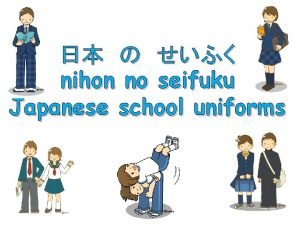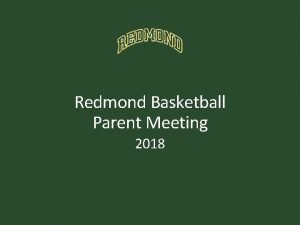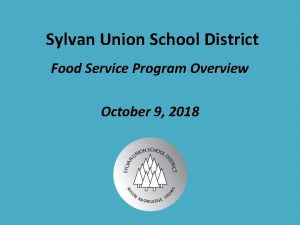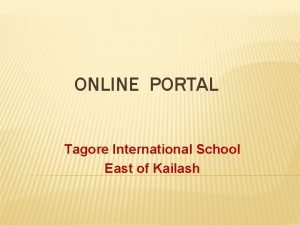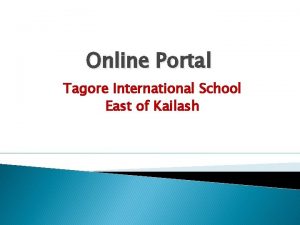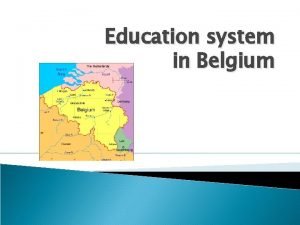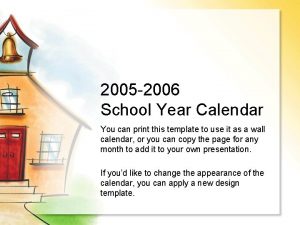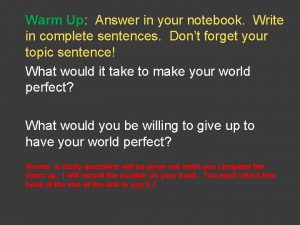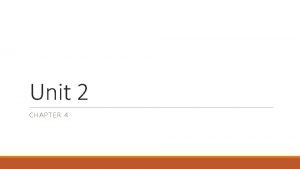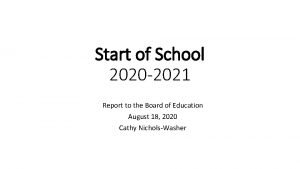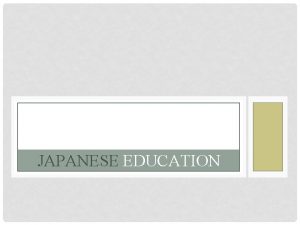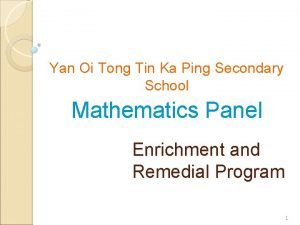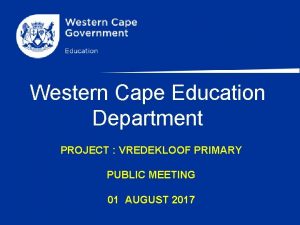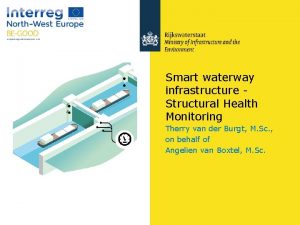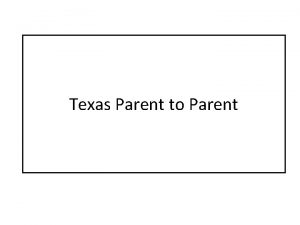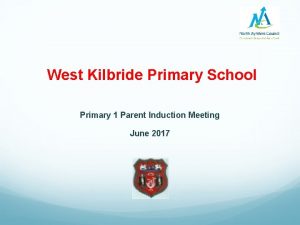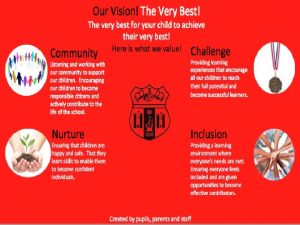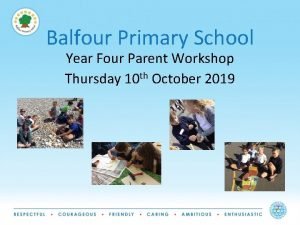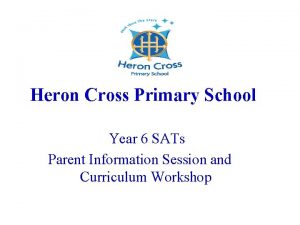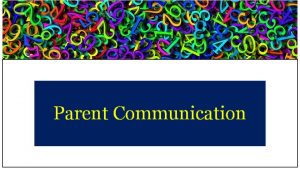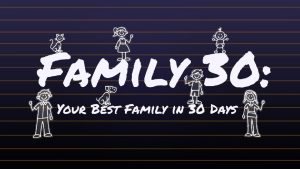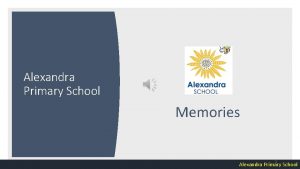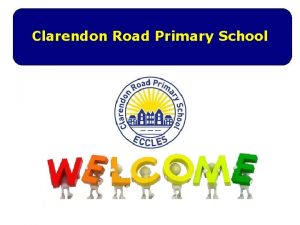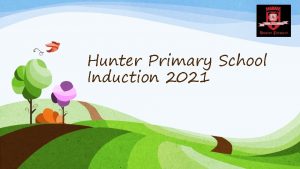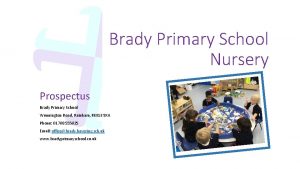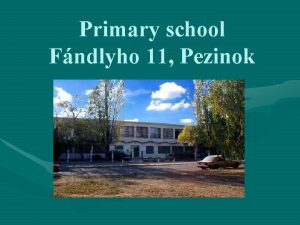Fr John Therry Primary School Year 1 Parent



















- Slides: 19

Fr John Therry Primary School Year 1 Parent Information Session on Student Reports

Reporting to Parents The Catholic school respects parents’ fundamental human right to know, to understand, to share, in decisions that affect the education of their children. Walking His Way, Telling His Truth, Living His Life: Implications of Ecclesia in Oceania NCEC 2003 March 2006 CEO Sydney 2

What is Reporting is a process designed to provide information to various stakeholders about student learning. The reporting process at the school level involves a range of strategies. These include: • Assessment comments on student’s work • Teacher feedback to students about the students’ learning • Informal interviews and meetings between parents/care-givers, teachers and, where appropriate, students • Formal parent-teacher interviews which may involve the student • Formal written reports. Reporting is a process of communication. The reporting process aims to meet the reporting requirements of parents/care-givers and the educating community whilst maintaining the dignity and respect for the child and the integrity of the curriculum. March 2006 CEO Sydney 3

• Reporting to parents at Fr John Therry occurs throughout the term and provides information about student progress and achievement. Reporting includes work samples, work books and meetings between the parent, teacher and possibly the student. • The written student report to parents is a specific and formal part of the process of communicating learning to parents and care-givers. Written school reports to parents provide summative interpretations of student progress and achievement. Schools are responsible for developing and managing the process of reporting to parents about student learning. • In addition to the school report on the student parents also receive reports on their child in Year 3 and Year 5 through National Assessment Program Literacy and Numeracy. March 2006 CEO Sydney 4

Reporting to Parents - What the research tells us: March 2006 CEO Sydney 5

Parents place a higher priority on receiving information about their children’s progress than any other type of information they receive from schools. The majority of parents express a degree of satisfaction with the information they currently receive, although they also believe that the process could be made more efficient. Cuttance and Stokes 2000 March 2006 CEO Sydney 6

1. Give a fair and honest assessment, in plain language. 2. Provide objective standards which determine the child’s attainment and rate of progress 3. Comprehensive, interpretative and constructive reporting 4. Alignment of reporting formats (eg school report and BST report are similar) 5. Appropriate timing of reports (earlier rather than later) and prompt reporting of any learning and/or behavioural problems 6. Reports that are tailored to individual children 7. Parent Teacher interviews which are focused and interactive 8. Children be part of the reporting process March 2006 CEO Sydney 7

Government Requirements • Written Reports to parents twice a year followed by the opportunity for a parent/ teacher interview. • Reports to be written in plain language • Students to be graded A-E against syllabus standards • Information made available to parents showing comparison of student achievement against other students in their year. March 2006 CEO Sydney 8

A-E grade scale A. The student has an extensive knowledge and understanding of the content and can readily apply this knowledge. In addition, the student has achieved a very high level of competence in the processes and skills and can apply these skills to new situations. B. The student has a thorough knowledge and understanding of the content and a high level of competence in the processes and skills. In addition, the student is able to apply this knowledge and these skills to most situations. C. The student has sound knowledge and understanding of the main areas of content and has achieved an adequate level of competence in the processes and skills. D. The student has basic knowledge and understanding of the content and has achieved a limited level of achievement. E. The student has an elementary knowledge and understanding in few areas of the content and has achieved very limited competence in some of the processes and skills. March 2006 CEO Sydney 9

• This section of the website provides support for assessment and reporting in the primary years: Kindergarten through to Year 6. The initial goal of this section of the website is to assist primary teachers to allocate grades (A to E) to their students. Samples of student work provided will illustrate the quality of work typically produced by students who achieve each grade on the Common Grade Scale. • View samples of student work and activities below. The work samples are aligned to the Common Grade Scale – representing grades from A to E. Further work samples and activities will be added progressively. • March 2006 CEO Sydney 10

This work has been given a B grade in Stage One Mathematics. The student has a thorough knowledge and understanding of the content and a high level of competence in the processes and skills. In addition, the student is able to apply this knowledge and these skills to most situations Jordan has accurately matched analog and digital time using correct placement of numerals and hands on the clock faces. There is evidence of thorough knowledge, recall and application to real life situations. Each activity has been matched to an appropriate time of day and there is evidence of the linking of ideas, concepts and mathematical notation. March 2006 CEO Sydney 11

This work has been given a D grade in Stage one Mathematics. The student has basic knowledge and understanding of the content and has achieved a limited level of achievement. Pat has demonstrated basic understanding of time in digital and analogue format. Numerals have been correctly placed on the analogue clock face but there is an inconsistency in the drawing of the hands of the clock and in the numerals. Mathematical terminology is used appropriately but there is some discrepancy in the analogue and digital time recording. March 2006 CEO Sydney 12

Sample One: Stage One students midway through the stage (end of Year One) were asked to draft and write a factual description of a toy.

Commentary Common Grade Allocation A Reese has demonstrated an extensive understanding of the features of a factual description. The text has been well structured and includes an effective concluding comment. A clear image of the toy has been provided through good use of details and descriptive language. Compound sentences have been used, and similes and adjectives have been included. A very high level of competence in spelling and punctuation is evident, but some commas and a possessive apostrophe are missing. To progress further, Reese could vary sentence beginnings more and include adverbial phrases. This work sample demonstrates characteristics of work typically produced by a student performing at grade A standard midway through Stage 1.

Sample Two: Stage One students midway through the stage (end of Year One) were asked to draft and write a factual description of a toy.

Commentary Common Grade Allocation C Drew has demonstrated a sound understanding of the features of a factual description. The text has been adequately structured but lacks an introduction or classification and a conclusion. Simple sentences have been used and the sentence beginnings are repetitive, but some adjectives have been included to describe the toy. Most of the punctuation is correct and adequate strategies have been used to spell words. This work sample demonstrates characteristics of work typically produced by a student performing at grade C standard midway through Stage 1.

Questions about A-E • If my child gets the same grade at the end of year report as they did at the half yearly, does this mean they haven’t made any progress? No • If my child gets an ‘A’ does this mean they have covered all the syllabus requirements for that stage of learning? No • Are teachers required to allocate a percentage of A’s, B’s, C’s etc. . to their class of students? No • Can I request that my child not be reported in this way? Yes March 2006 CEO Sydney 17

Reporting Comparative Information – on request Year 3 Number of Year 3 students in the school achieving grades A – E Grade English Mathematics A 16 students 17 students B 24 students 20 students 25 students C 12 students 14 students D 9 students 14 students E 4 students March 2006 HSIE Science & Technology Creative and Performing Arts Personal Dev, Health and Physical Education 2 students 17 students 30 students 23 students 24 students 20 students 30 students 20 students 14 students 15 students 13 students 4 students 2 students 1 student CEO Sydney 18

Questions and Comments Catholic Education Office, Sydney March 2006 CEO Sydney 19
 Twinkl year 6 leavers poem
Twinkl year 6 leavers poem School uniform in japan
School uniform in japan Basketball parent meeting powerpoint
Basketball parent meeting powerpoint Sylvan union school district lunch menu
Sylvan union school district lunch menu Tagore international school east of kailash parent portal
Tagore international school east of kailash parent portal Tagore international school parent portal
Tagore international school parent portal Yellow magenta and cyan are the ___
Yellow magenta and cyan are the ___ 2008-2009 school year
2008-2009 school year Polytechnic education
Polytechnic education May 2006 calendar
May 2006 calendar Welcome to senior year
Welcome to senior year Year 10 school certificate
Year 10 school certificate Someone gives the school gerbils every year
Someone gives the school gerbils every year In your notebook write three paragraphs
In your notebook write three paragraphs In your notebook write down
In your notebook write down End of year school reports 2021
End of year school reports 2021 Japan school system
Japan school system Yan oi tong tin ka ping secondary school
Yan oi tong tin ka ping secondary school Yiu tupe
Yiu tupe Meed wced
Meed wced

